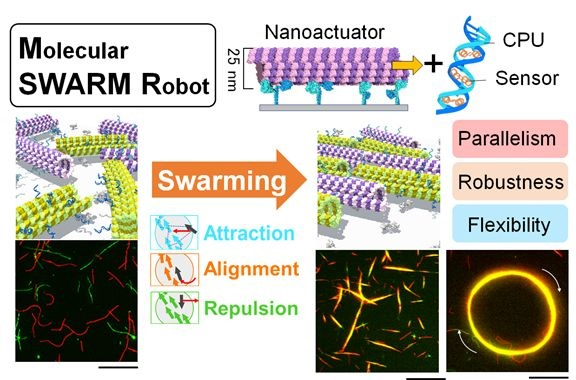Jun 22 2020
Multi-disciplinary research has led to the innovative fabrication of molecule-sized robots. Scientists are now advancing their efforts to make these robots interact and work together in the millions, explains a review in the journal Science and Technology of Advanced Materials.
 A molecular robot, which is typically between 100 nanometers to 100 micrometers long, requires an actuator, processor and sensor to function properly. By fine-tuning their mutual interactions, millions of robots can move together in swarms that are much bigger in size than a single robot, offering several advantages. Scale bar: 20 μm. Image Credit: Akira Kakugo
A molecular robot, which is typically between 100 nanometers to 100 micrometers long, requires an actuator, processor and sensor to function properly. By fine-tuning their mutual interactions, millions of robots can move together in swarms that are much bigger in size than a single robot, offering several advantages. Scale bar: 20 μm. Image Credit: Akira Kakugo
"Molecular robots are expected to greatly contribute to the emergence of a new dimension in chemical synthesis, molecular manufacturing, and artificial intelligence," writes Hokkaido University physical chemist Dr. Akira Kakugo and his colleagues in their review.
Rapid progress has been made in recent years to build these tiny machines, thanks to supramolecular chemists, chemical and biomolecular engineers, and nanotechnologies, among others, working closely together. But one area that still needs improvement is controlling the movements of swarms of molecular robots, so they can perform multiple tasks simultaneously.
Towards this end, researchers have made molecular robots with three key components: microtubules, single-stranded DNA, and a light-sensing chemical compound. The microtubules act as the molecular robot's motor, converting chemical energy into mechanical work. The DNA strands act as the information processor due to its incredible ability to store data and perform multiple functions simultaneously. The chemical compound, azobenzene derivative, is able to sense light, acting as the molecular robot's on/off switch.
Scientists have made huge moving ‘swarms' of these molecular robots by utilizing DNA's ability to transmit and receive information to coordinate interactions between individual robots. See the video below.
Can DNA Control Molecular Robots?
Scientists have devised a new method of using DNA to control molecular robots. Molecules swarm like a flock of birds, showing different patterns of movement when this method is applied. (Video Credit: Hokkaido University)
Scientists have successfully controlled the shape of those swarms by tuning the length and rigidity of the microtubules. Relatively stiff robots swarm in uni-directional, linear bundles, while more flexible ones form rotating, ring-shaped swarms.
A continuing challenge, though, is making separate groups of robots swarm at the same time, but in different patterns. This is needed to perform multiple tasks simultaneously. One group of scientists achieved this by designing one DNA signal for rigid robots, sending them into a unidirectional bundle-shaped swarm, and another DNA signal for flexible robots, which simultaneously rotated together in a ring-shaped swarm.
Light-sensing azobenzene has also been used to turn swarms off and on. DNA translates information from azobenzene when it senses ultraviolet light, turning a swarm off. When the azobenzene senses visible light, the swarm is switched back to on state.
"Robot sizes have been scaled down from centimeters to nanometers, and the number of robots participating in a swarm has increased from 1,000 to millions," write the researchers. Further optimization is still necessary, however, to improve the processing, storing and transmitting of information. Also, issues related to energy efficiency and reusability, in addition to improving the lifetime of molecular robots, still need to be addressed.